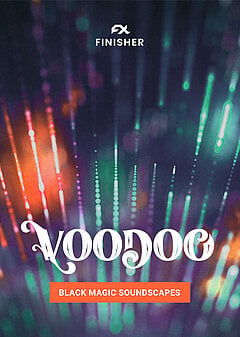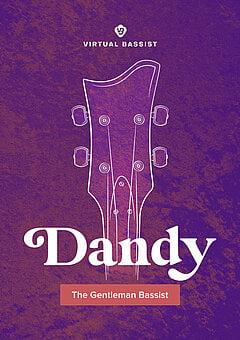How to Make Your Bass Sound Unique
Give your bass the attitude and energy your song needs to stand out in any genre, no matter the style with effects like Finisher VOODOO.
SEPTEMBER 13TH , 2020
Most producers want to sound unique, and understandably so. To that end you can layer synths, design your own sounds, and even work in crazy effect chains. But when it comes to bass, it’s easy to fall into the trap of simply adding in a slightly dirty sub and calling it a day. With the nearly infinite array of tools at your disposal as a music producer, you have no shortage of options for giving your bass a specific attitude and energy. Let’s take a look at a few of your options.
Electric vs. acoustic basses
While there’s no limit to the ways you can manipulate an instrument, acoustic and electric instruments have different inherent tolerances to being put through the ringer. You’ll probably find you can layer effect after effect on an electric bass, but for an upright bass you’re better off making only minimal tweaks. There are no official rules here, of course, but it’s generally safer to add dramatic effects when the instrument starts off with its own processing (through an amp, for example).
That being said, you should try overdriving an upright bass to see what it sounds like--even if in context it sounds like complete garbage, make a mental note of when that particular sound could be useful (one song’s trash is another song’s treasure!). This leads into another important point: Even if you create the greatest bass sound of all time, it obviously won’t work in every song. There are too many genres with far too many variations. So you should frequently ask yourself (for everything, not just basses): “Does this sound accomplish what I want it to?” If not, don’t be afraid to scrap your effect chain and start over--you’ll suffer far less than you will while attempting to mold an inappropriate sound to fit into your latest song.
Turning a clean bass into a rocking monster with audio effects
Whether you’re working with a real, direct line-in bass or a Virtual Bassist, you start out with a clean (dare we say bland) signal. In almost every case, you’ll want to add a bit of spice, namely through audio effects and varying the performance style.
To make quick but dramatic changes to your bass, try using a tool like Finisher VOODOO that combines delay, saturation, phasing and a range of other effects in a simple interface. If you decide to add effects à la carte, there’s no predetermined signal chain order that works best. But remember this: the order of your effects does matter, because each additional effect you add affects everything that comes before it.
Case in point: say you EQ your bass, add some flanging, then apply distortion and finally some reverb (very rare that you’ll use reverb on a bass, but this combo has its moments). Now take the same signal chain but flip the order of the distortion and reverb. What used to be a screaming bassline with some gentle ambience now becomes a mucky, angry bassline with smeared pitch. All because you’re now distorting a signal with reverb, a pleasantly dangerous combo for sound design purposes but usually too unwieldy for melodic and harmonic instruments.
Shaping the bass sound with articulations
If you work with a lot of synthesizers, you’ll be familiar with the volume settings Attack, Decay, Sustain and Release; this blog post from Landr explains the concept quite well if you need a refresher.
(The short version is: attack = how long it takes to reach full volume, decay = how long it takes to reach resting volume, sustain = resting volume level, and release = how long it takes for the volume to reach 0 after the note has been released)
By default, you’ll probably opt for a bass with a very long decay, but don’t feel limited by that. A short, plucky setting might be necessary if you want to get a glitchy, precise bass line. For an electric bass, you have the option to add in muted notes here and there, or even play an entire passage muted.
If you’re willing to put in the editing time, consider playing with note lengths and articulations (this is admittedly much easier with virtual instruments than it is with live recordings). Do this before you even touch any effects--because the closer you can get to your desired sound by subtracting, the more effective you’ll be at adding just the right pieces.
Real vs. virtual bassists
There’s a key difference in workflow between live performers and virtual instruments, and it lies in the human element. Musicians often have a specific rig with go-to effects. As much as possible, discourage them from using these if you’re not positive their effect chain will yield the exact sound you want.
This is especially true of remote work, because your musician will have to send you raw audio files, and it’s unlikely that you both have the exact same effects in your arsenal. Have them record dry or at least send some samples over before committing to a sound--that way, you have maximum flexibility when adding your own effects like with VOODOO, an excellent tool for gently polishing your bass sound or even mangle it into oblivion.
Adding creative effects to your bass
To get an edgy classic rock feel, open up VOODOO’s One String Only preset--you’ll hear strong Led Zeppelin and Pink Floyd influences that should give you some quick inspiration. Or Rage Against for some dark, gritty industrial distortion that sounds like it came right out of a video game score. And it may be cliché to say...but the options really are limitless!
This is where virtual bassists have an advantage: you can add and strip effects as you wish without ever having to commit to any of them. Of course, this also means you can go in circles indefinitely; for that reason, some producers prefer to render the effects to avoid excessive second guessing.
When to use a clean bass
As you develop your critical musician’s ear, you’ll notice plenty of times when a subdued, plain bass is actually the best option. If the vocals, lead, or even chords need as much attention from the listener as possible, your bass shouldn’t steal any of the limelight. Wait for the right opportunity to let it sing, and endeavor to pleasantly surprise your audience.
One of the most fun things you can do is to juxtapose a boring bass sound with an intensely exciting one--then when you decide to finally unleash all the bells and whistles, you’ll create a much greater impact.
Don’t mistake clean with no effects; if you’re comparing your music to examples with relatively uninteresting basses (i.e. no phasing, delay, etc.), you might be tempted to believe the sound is untreated. But listen more carefully--because more likely than not, that bass was treated with EQ, compression and saturation (at the very least). The fact that this is difficult to notice is a testament to how subtle differences add up to incredible final mixes.
The moral here is that quite often, with basses less is more. Understanding the tools you have at your disposal provides you with opportunities, but you don’t always have to flex your producer’s muscles. Learn when to hold back and when to let loose. And when in doubt, go with whatever feels the most fun!
Stay up to date
Sign up and we’ll send you an e-mail with product news and helpful stuff every now and then. You may unsubscribe at any time.
Defy Limits
We develop software solutions that enable people to create, consume and interact with music.




